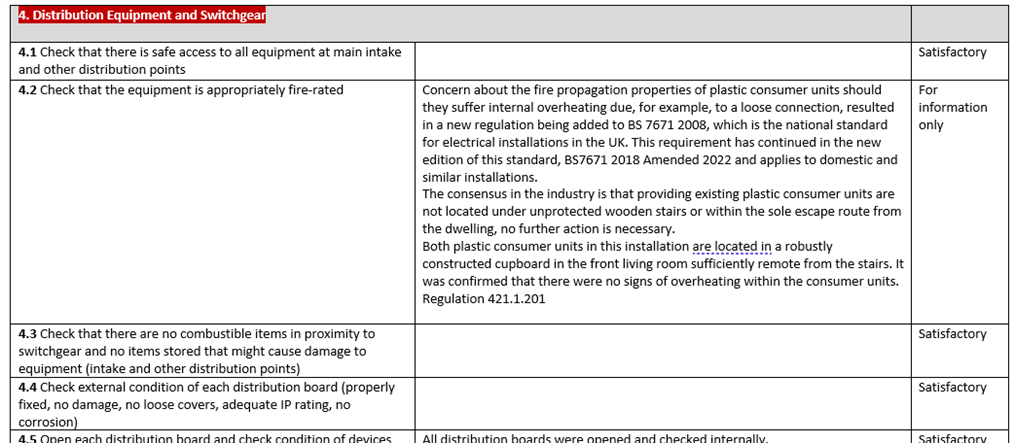This installation has received a C3.
I am tempted to do nothing as an electrician has quoted about £600 to replace the lot with a board full of RCBOs.
Is there a simple way of improving the fire rating?
This installation has received a C3.
I am tempted to do nothing as an electrician has quoted about £600 to replace the lot with a board full of RCBOs.
Is there a simple way of improving the fire rating?
Was a detailed reason given for getting a C3? At first glance, this looks fine.
As someone else has mentioned it might not even need to be a C3, unless it’s in an escape route/under stairs and no signs of thermal damage, then no code would be needed. Be interesting to know the setting of the consumer unit.
Indeed, knowing the consumer unit’s designation would help. However, it appears that the inspector has identified potential safety improvements could be possible, as evidenced by the attached C3 code. Is the presence of a wooden staircase and its location along an escape route the sole criterion for issuing a C3 observation? I am curious if there might be additional factors contributing to this classification.
Is the absence of the previous Observation Code 4, (Periodic Test & Inspection document) which addressed non-compliance with current regulations, a matter that warrants reconsideration?
As an advocate for thoroughness, I advocate for Condition Reports to be structured akin to technical reports rather than overly simplified documents. Elaborating on each observation, rather than relying on concise one-liners, ensures clarity and precision. It is essential to recognise that even domestic installations possess technical intricacies that may confound those without specialised training.
Moreover, in my opinion, it is justifiable to inform property owners that their existing arrangement no longer aligns with current standards, particularly in light of past consumer unit fires. Additionally, raising awareness about contemporary safety enhancements such as Type A RCDs, AFDDs, and SPDs serves to enhance overall safety consciousness.
Even if it’s just added to the additional notes section
If you moved into a house with that CU what would you do?
I doubt that any of us would put modernising it at the top of our to do list, so not a C1 or C2. However, I think that it would be pencilled in lower down, so that makes it a C3.
For me, it is as much to do with split load (presumably type AC RCDs) and lack of SPD protection as the fire rating. In essence the recommendation is simply to bring it up to the current standard, so I find it difficult not to grade C3.
Of course, it might be 20 years until you get round to the upgrade.
I agreed. Don’t you think that this scenario bears resemblance to the absence of a Circuit Protective Conductor in a lighting circuit equipped solely with Class 2 accessories, which also falls under the C3 classification. One would seek this information proactively before enlisting a friend to install a new Class 1 fitting, much as one would verify that their consumer unit is constructed of plastic prior to introducing an additional load such as a hot tub (As small as 13 amp plugged in) that could potentially subject the existing consumer unit to thermal stress and lead to a fire outbreak within the unit.
We don't do much in the domestic side but for tenanted properties I think it reasonable to advise the landlord about the concerns relating to plastic consumer units. I am not so sure about mentioning the issue in privately owned dwellings providing all seems good. No sense in worrying people unnecessarily. We don't use the standard Appendix 6 forms, preferring instead, to note the observation against each check.

That sounds to me that you want to give a C2 if it is under the stairs, etc.
To answer your query, yes, there is a cheap way to rectify it, you can buy steel enclosures to fit over the plastic consumer unit . These are typically £50+, but may be a bit difficult to fit correctly, as they work best on a flat surface.
TBH, I'd be looking at getting a new consumer unit. As has been mentioned by others, you have no SPD or Type A RCD protection, as well as the plastic casing. £600 is at the top end of prices I'd say. The parts will be £150ish for a 6 way RCBO/SPD CU, £450 for 4 hours labour (if that) seems a pretty good deal for the Electrician.
We're about to take you to the IET registration website. Don't worry though, you'll be sent straight back to the community after completing the registration.
Continue to the IET registration site